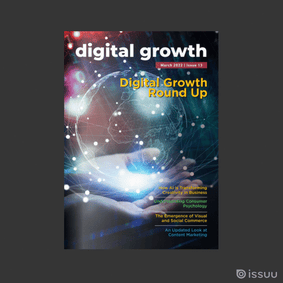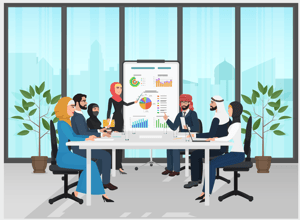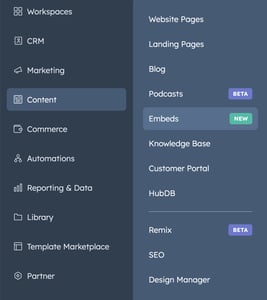Luke Summerfield is a Product Go-to-Market Lead at HubSpot working in the Product Leadership Team for CMS Hub. We spoke with him to find out about how the HubSpot CMS is helping businesses to create successful websites with optimal user experiences that are in line with industry best practices and developments.

Q: HubSpot has been at the forefront of CMS technology and has made website building easier for marketers and businesses. What makes the HubSpot CMS such a stand-out in the eyes of marketers and business owners, Luke?
A: I think there are 4 unique benefits that come with the HubSpot CMS that are important to consider:
1) Businesses that succeed are the ones that create world-class, personalized experiences. In the past, it was mainly about who had the best methodology or technology but in 2021, it is about how you take methodology and technology and bring it together on behalf of your customers.
Essentially, the CRM and CMS are joined at the hip and work together to help empower marketers and businesses to create those world-class personalized experiences, in ways that are very difficult, if not impossible, in other systems.
With this in mind, the first thing that stands out about our CMS is that the system is a CRM powered CMS, meaning that all the rich customer data and interactions you have to give you a fully rounded view of who your customer is paired directly with the experiences that that customer has. This allows you to craft those experiences based on all the information that you have. So, the HubSpot CMS is designed to help you create the ideal personalized customer experience.
2) The second thing that makes the CMS so unique is that we recognized that a website should not just be a brochure, it is an asset that can help a business grow. And the CMS is designed to turn a website from a static brochure into a growth investment. The CMS comes with everything a business and marketer would need to drive business growth including SEO tools, conversion optimization tools, reporting tools, contact attribution tools (to measure ROI), etc.
3) In the past CMS’s were very difficult for marketers to “own,” they always had to work through someone to make any changes to the site. And because of this, the sites could end up becoming stale. This can quickly become an issue as marketers are at the mercy of other people and these other people can inevitably hold up sales and business growth.
What makes the CMS stand out is that it's built on SaaS infrastructure which means no one has to worry about security or updating plug-ins and you can just spend your time focusing on the customers and building those experiences without the headaches of third parties, maintenance, and security issues. The system is designed to empower marketers to get their work done, and to own the website, and have autonomy on using the website to drive better results. And this is not to say that developers aren’t a part of the process, they are absolutely important, but now the developer is able to work together with the marketing team, allowing them to edit elements together in real-time, giving the developer the opportunity to set the system up to empower the marketer.
Essentially, HubSpot CMS takes care of all the annoying stuff that people don't like to do anyway, freeing your time up to get your work done.
4) In the past, businesses had two choices when it came to CMS’s, these begging: “Do I go with something that is very powerful but difficult to use?” or “Do I go with something really simple to use but is not flexible and doesn’t scale with my business?”
And we have taken the above into consideration and created a streamlined system for marketers and developers to use and at the same time.
Q: In the past, uploading content and making website changes would be a timely process and, of course, cost businesses money. With the introduction of CMSs this all changed. How does the HubSpot CMS save businesses time and money when it comes to content creation, web design, and related website requirements?
A: The fact that the CMS is an all-in-one platform is a huge time saver because you no longer have to find plug-ins and spin up an external server, custom code functionality, set up hosting, etc. In the past, setting up a CMS was like having to go to the store and buy every single lego black from a different store. With HubSpot, you have all the lego blocks right out of the box. It’s a ‘kit’ that also comes with really clear instructions to help you put everything together. And this is saving everyone from marketers to developers an enormous amount of time.
As we discussed previously, the system empowers the marketing team to get their work done. And things that would normally have taken days or weeks to complete can now be completed in minutes.
Many CMSs have hidden costs that trickle in including hosting, security, maintenance, and plug-in updates, etc. In a SaaS CMS, all of this is taken care of, yes you pay for it, but you don’t have to even think about it and all you have to focus on is your business and growing your business.
Q: Is the HubSpot CMS simply a web building tool or does it work alongside other website necessities such as SEO, content management, lead generation, and reporting?
A: We’ve had people tell us that we shouldn't have even called it the CMS Hub and we should have rather gone with “Business Growth Hub” or something along those lines. But at the end of the day, a website is a tool that you should leverage for business growth - and simple content management and web building are only one piece of the puzzle. We feel like a CMS should provide the entire business growth experience from SEO and asset management to conversion optimization and CRM database integration. All the features offered in our CMS can be found here, and this should give you perspective about how the CMS is built for business growth and more.
Another feature to consider is that we bundle in our entire conversational platform in the CMS Hub. This means that you don't just get the CMS, you also get live chats, Facebook messenger, etc which allows for a greater customer experience.
Q: When it comes to building a website and reporting on a website, every user has individual goals and requirements. How does the HubSpot CMS cater to user personalization?
A: As discussed previously, our CMS is a CRM powered CMS designed to create a personalized customer experience - and the CRM data can be brought to bear on the customer experience in a couple of ways:
- We use a tool called “Smart Content” that allows you to dynamically change elements or sections of a page around specific content based on individual customer data you have in your CRM. There is also tracking on this tool, which allows you to report on the performance of different content variations that you’re personalizing for the individual.
- We have a relatively new feature that can be set up by a developer, allowing them to select any objects within the CRM, and display specific objects to someone on the site. With this, you can begin to become incredibly sophisticated with what you are displaying to an individual. Essentially you know what product or object the visitor is interested in and you can tailor the messages around the “object” they are interested in on your website. This is all done by extending CRM data to the frontend of the site.
- We have had the ability to do dynamic content on the site. That is: being able to build a directory, resource library, or locations finder where all the pages within that section are dynamically generated based on both HUB DB or you can now generate those pages from content/objects that live in the CRM. This means you can build hyper-dynamic experiences very quickly and easily.
Now that we have an understanding of the HubSpot CMS, we would like to pick your brain about website design and website development in 2021 and beyond.
The Future of Websites
Q: There are reportedly 1.8 billion websites in the world. What’s the best way to make sure yours doesn’t get lost among them?
A: This is similar to content marketing because we’ve seen this happen with blogs and eBooks - it’s not novel anymore. Id’ recommend:
- Set yourself up for success to get found in the first place. That means having the baseline for a good user experience - the site is safe, reliable, always available, blazing fast, responsive on all screens, and that it’s accessible (legally and ethically). We have an auditing tool you can use to check this called websitegrader.com.
- Find focus on your website. Be laser focus on who your site is for, who you’re solving for, and the types of content you have on there. The generalized sites that are pumped but we’re seeing that type of content isn’t successful and doesn’t help your audience as they bounce and leave. The more focused you can get, the better.
- Ensure absolutely everything on your site is remarkable so that you’re confident that if the right person finds it, they’re going to be blown away. It needs to be world-class, personalized, and give in-depth, helpful content. The quality level should be worthy of someone paying for it, but you’re offering it for free and making it shareable.
Q: What does the future of the user experience look like?
A: I think it’s going to be about an experience of one. Back in the day, you’d have one experience for everyone, then it got to an experience for groups or distinct segments with more tailoring. Where we’re going and where a CRM-powered CMS helps is in the experience of one. Over time, the more a business learns about a customer, the more the experience gets tailored around that prospect and personalized experiences lead to different experiences on the same site for every single person that visits the site.
User experience to customer service is moving from a nice to have to a core pillar for driving business. It’s going to be baked into more of the culture and operating system versus being an afterthought or a bolt-on to a bigger project.
Q: Where do you see developments in AI, voice search, and VR headed when it comes to websites?
A: While I don’t have in-depth knowledge on these, I can share some conceptual ideas that I find interesting about them. They essentially lower the effort it takes to solve a problem and relentlessly remove friction for the customer. Certain experiences should be immersive, which is where VR comes in. It creates a powerful experience and bridges the gap to becoming more inclusive by being more accessible.
Q: For viewers, a website is a digital storefront destination. To provide the best experience, though, there’s a lot that goes on behind the scenes relating to tech and internal business functions. Can you tell us about the kind of integrations that are necessary under HubSpot’s all-in-one umbrella?
A: The most important thing is that you have a source of truth to rely on for your customer. The source of truth gives you a complete view of the customer - this is your CRM or customer data platform. When you look at those integrations, you have to find where there are currently silos in the solutions that you want to build, from your websites to messengers, in-person experiences, etc. It’s about moving those into one spot and investing the time and energy to do so. This unlocks doors and gives you understanding about your customers which is the key to winning. With HubSpot, that comes right out of the box, whatever is outside can be integrated.
The other thing that I think is interesting is that HubSpot will never be the absolute best for any small point solution category. We always give the majority of what is needed for an individual category, but there are going to be certain spots where your company has more sophisticated needs. Just knowing that having our various Hubs allows you to find the right tool for the job you need and not miss a beat when tying it all together.
Q: Which web creation mistakes should people avoid going forward?
A: The biggest thing that I would recommend is not talking to your customers. It boils down to:
- People underestimate how much they know about their customers.
- They skip the strategy and go right into building.
- They don’t take the time to do qualitative research regularly using feedback mechanisms.
- They don’t combine the quantitative and qualitative data.
Pro Tip: The number one thing you can do is talk to 10 people who recently switched to your product or service and find out what made them switch - anxieties, questions, pains, breaking points. Understanding that switch is critical and marketers need to understand how to make those switches better, easier, faster, and cheaper. Then speak with 10 of your customers who recently left your company for a competitor and ask questions to find out the reasons why.
People want to fast-track this by looking at quantitative factors to get the answers. That information is great in helping you understand an angel and perspective - what, where, which segment it happened, but data and reporting don’t tell you why. You’ve got to mix the sets of data to help you understand the golden nuggets of why, and then you can build a strategy.
The second thing I’d recommend which is related is underestimating how important positioning, messaging, and content are. There is way too much focus on technology, the details, and design too early on. At the core, the positioning, the focus, the messaging, the copy is critical. People either breeze through it, don’t invest enough time in it or do it way too late in the process.
We see that a lot where web projects stall out because they waste time or are not willing to hire a storyteller to figure that out. It misses the mark by creating something that your actual target market doesn’t connect with, so you don’t see the results. Then you’re optimizing on something that no one cares about, to begin with.
Lastly, there are too many ‘set it and forget it’ approaches to websites. This is when a website is created and moved on from, which means the website can become stale. Instead, see the site as an asset that requires continual investment (like spending time on it) which can also be used as a tool for the marketing team (and all the teams), since the digital experiences can help everyone in the organization with what they’re trying to do.
The Wrap Up
Q: Could you give us some insider info on HubSpot’s upcoming product launches?
A: Have a look at the HubSpot Product Roadmap for platform updates in the CMS Hub. There are exciting developments like Developer Sandbox to enable developers and marketers to work together on premium website experiences. Collaboration tools are coming to the app so that you can communicate where you work and be able to better manage the approval processes for content. The other one I’m excited about is Digital Asset Management which has features and recommendations to help with organizing and optimizing. The last one is Content Decoupling. We’re working on HubSpot being an all-in-one source of truth where you can own and update the experience by extending the .com website to omnichannel distribution. This will allow marketers and developers to work together on extending content into other digital experiences.
Thank you so much for your time, Luke! Much appreciated.
Learn more about HubSpot CMS.
%20(1).png?width=2701&height=607&name=BRC_NEXA_LOGO_BLACK%20%26%20VIOLET%20(1)%20(1).png)
%20(1).png?width=2701&height=607&name=BRC_NEXA_LOGO_WHITE%20(2)%20(1).png)















Comments